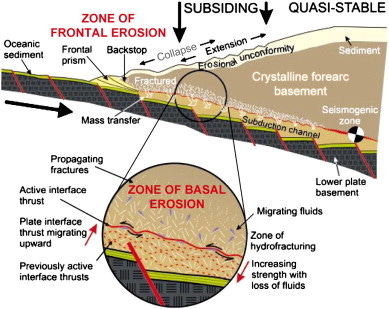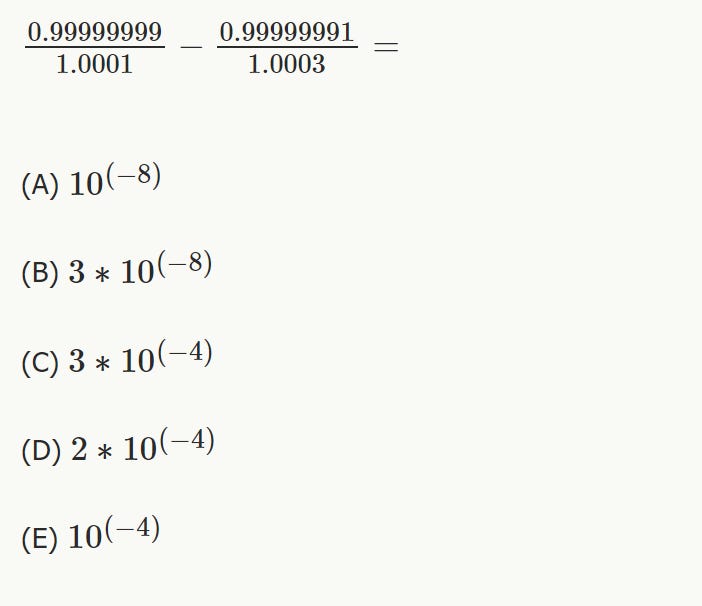One of the more enlightening experiences I had in college was when I was struggling with my senior thesis. It may surprise readers of my blog to know that my senior thesis was in geology, specifically about figuring out the mass balance of the Aleutian Island chain.
The mass balance, as the name might suggest, is how much mass the Aleutian Island chain is gaining or losing over time. This is a wildly difficult problem, mainly because the main way the Aleutian Island chain loses mass occurs far below ground through subduction [1]. The only way of estimating this mass loss is to use proxies, but there’s no easy way of establishing the relationship of the proxy to the Aleutian Island chain itself, and the proxies themselves are difficult to come by. These sorts of problems are very common in geosciences, which is a big reason why I left the field behind [2].

One day, as I was struggling to think about this massive problem (pun intended), I happened to be talking with a geophysicist. Now geophysicists, as the name suggests, are physicists who happen to work in geology. Like most physicists, they are, by and large, brilliant, somewhat socially awkward, and unable to understand how others can’t find physics as easy as they do. They tend to work on earthquakes and problems relating to them, like using earthquakes to pinpoint where mineral deposits are in the earth [3].
This specific geophysicist, although still a bit awkward, was very friendly. He asked me about my thesis, and I told him the problem I was facing. He nodded, asked a few clarifying questions, and then headed over to his chalkboard and started rapidly sketching and talking, “Well, if you think of the subduction zone like this, and the crust like this, what you’re really looking at are these three factors. Now if we assume a steady state about the first two factors, the only source of uncertainty is the last factor [4]. Does that make sense?”
I was astounded. In about 5 minutes of thinking about my senior thesis problem he had made more progress than I had in months. And it hadn’t been because he had much more knowledge about the problem I was working on. Instead, it had been his intuition, and the clarity of his thought. He took a complex problem and distilled it down to essentials.
There was some sense in which it was like a magic trick, some brilliant left-brained mind making cogitations that my largely right-brained mind could follow but feebly. However, I think like all magic tricks, there was also a lot of practice behind it. Not practice specifically in the field I was studying, but practice in reducing complex geological systems down to basic moving parts.
I’ve since left geosciences behind. My professional time these days is split between biotech and test-prep, due to my weird split life (although my time might go much further towards biotech very soon, depending on how the next few weeks play out).
In biotech, I personally rarely see these sorts of intuition at play, although I think that’s because I gravitate towards subfields where there are too many unknowns. In test-prep, however, I actually explicitly try to teach intuition, which gives me interesting insight on how it might work in the sciences.
Test-prep is interesting because, unlike science, it’s all about mastering a limited and very well-defined set of concepts. Although the ways in which the concepts can be tested are manifold, the concepts themselves are not. All problems are solvable, and all problems have the correct answer as one of the multiple-choice questions.

That means that one of the most important skills a test-taker can develop is how to recognize an existing problem as an example of one they’ve seen before. Then they need to be able to apply their existing skills to this new problem.
When I teach test-prep, I explicitly teach how to recognize problems. I’ll say “These are the key elements of a rate problem. Whenever you see these elements, you need to immediately write down your rate equation and go from there.”
Then I’ll take my students through a variety of questions that are all variations on rate problems, so that they’re able to recognize the various forms of these problems. I’ll point out that a problem involving 3 men working on a birdhouse is essentially the same as two trains traveling to meet each other, as both involve a rate, a time, and a task/distance. So, both can be solved by figuring out rates and adding them together.
In effect, this explicitly teaches intuition for these questions. Students are often amazed when I look at a math problem I’ve never seen before and I’m able to solve it within two minutes, when they would struggle with it for hours on their own. However, once I teach them how I recognize problems and break them down into their component elements, they frequently are able to make those same sorts of leaps within 100-150 hours of studying.
I’m able to teach this because I know the sorts of concepts that these tests test, and I’ve seen a wide enough array of problems testing those concepts. This sort of teaching isn’t uncommon in test-prep, although I’m not sure everyone teaches it as explicitly as I do.
It is very uncommon pretty much everywhere else, though. I’ve taken a lot of science classes and a lot of math classes. The best of them do point out fundamental similarities in two seemingly disparate things, but I’ve rarely had a math or science class where they’ve tried to make students develop the skills of recognizing when a fundamental concept appears in a different form.
In tightly defined and well-understood fields, I think this would be simple enough to do, although a lot of work. The real problem would come into play in loosely defined and less well understood fields. Or, to be more specific about it, as a senior in college, could I have been taught the same intuition that the geophysicist had?
I want to say yes. The geophysicist presumably developed that intuition somehow. He wasn’t born with it. Given how smart a guy he was, he probably developed it using fewer examples than a mere mortal would need. But, it doesn’t seem fundamentally impossible. There are enough papers about geological phenomena that it should be possible to cobble together a curriculum that teaches intuition about geology.
From there, it’d be a matter of reversing the typical way of teaching a paper or scientific fact. Normally, science is taught as “here’s a general law of science. These are a few examples of that law in action.”
But, this would need to be taught as, “Here are a few seemingly disparate examples of different scientific phenomena. Here’s how they’re actually all fundamentally similar. Here’s what you can then predict or explain with the fact that they’re all similar.”
Crucially, both problem sets and tests would need to test the skill of recognizing the similarities and then acting on them. Students would be presented with a strange, specific phenomena, and then explicitly have to recognize it as an example of a broader concept and act on it accordingly.
The more concepts a student recognized, the better they’d be at eventually being able to recognize these concepts out in the wild. And then, hopefully, they’d finally be able to complete their senior thesis.
[1] Note: I’m relying on memory here. I used to know this stuff well, but I make no guarantees as to the accuracy of the current blog post.
[2] That, and an outright hostile attitude towards error-checking. As an undergrad, I found 3 separate highly-cited papers in 3 separate geoscience subfields with critical methodological errors, and was unsuccessful at getting any of them retracted or even revised. Even my professors weren’t particularly interested.
[3] Earthquakes cause vibrations to travel through the crust. The vibrations travel at different speeds depending on what the material is. You can use this (plus a lot of math) to figure out what the earth’s crust is made of. Also, geophysicists still can’t predict where or when earthquakes will occur, which is very embarrassing for them.
[4] This vagueness is entirely my fault, and was not present in his original explanation. The details of his exposition have been lost to the fog of my memory banks.